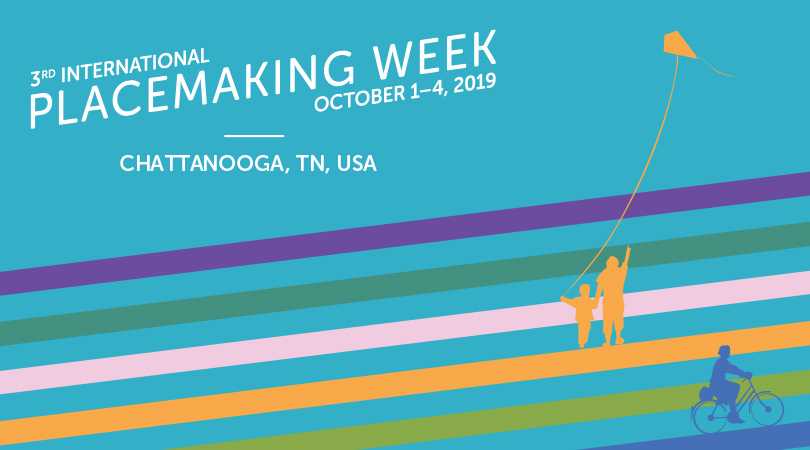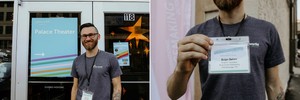Finding A Renewed Sense Of Opportunity
This week, Chattanooga hosted the 3rd International Placemaking Week conference, a gathering of activists and leaders who, “envision a place-led future for cities.” Speakers and attendees travelled from across the globe to take part in the event—seriously, there was a speaker from New Zealand, and we met a man who flew in from Holland!—and they were able to share the wisdom of their experience, many times with infectious, optimistic fervor.
Brian’s original design for ArtSpark references themes of inclusion and diversity.
So what does that actually mean? And what in the world is placemaking?
You could read Wikipedia or this explanation by Project for Public Spaces—the organization which puts on Placemaking Week—but essentially, it’s a way of improving cities by focusing on community-lead small-scale improvements to public space. They could be bike stations, parks, concerts, street lighting, covered bus stops, or mural installations, to name a few. The goal is to turn those initiatives into an empowering opportunity for residents, a grassroots method of improving cities one small step at a time.
Cool. And Riverworks does that?
No, we’re not patently in the business of placemaking, but one of our designers got involved with Placemaking Week at an early stage, licensing his artwork to the conference for their promotional materials and signage. They approached Brian after seeing his design for a wrap that covers an electric utility box through ArtSpark, a program that raised funding to decorate the unsightly boxes in downtown with artwork by local, Chattanooga-based artists. His design drew their attention by focusing on inclusion and diversity, which thematically align with the goals of placemaking.
During the conference, Brian attended sessions on a mural festival in small-town Michigan, how to authentically brand your space, and a short-talks session featuring rapid-fire, 7-minute presentations from various placemakers.
Hear it from Brian:
First, I want to say, Chattanooga has really done something right over the years to attract the attention of an international conference like this. (Beginning revitalization efforts with community meetings starting back in the ’70s, this city has been able to pick itself up and look to the future in a radically-local way. The model became what people are calling the Chattanooga Way—the idea that we can set aside our differences and focus on what we can do together. If you’re into this kind of stuff, there’s a Brookings case study on the city from 2008 that can give you more depth on that topic.)
Nerdy aspects of placemaking aside, I’m grateful to have had the opportunity to attend a handful of sessions in this year’s conference. As I sat back in Walker Theatre, I was struck by the optimism of the whole event. While many speakers gave nuts-and-bolts, under-the-hood details on their initiatives, the point was to share the models that worked and to spark imagination in others with the hope they’d step up and make a difference. These speakers believe deeply that change is possible—that our cities can be shaped by their residents in powerful and lasting ways.
Waking Up
When we first visited Chattanooga in 2015, my wife and I felt a sense of opportunity here. EPB had installed the fastest internet in the western hemisphere, population was growing, and real estate was affordable (at least comparatively for us, having come from large northeast cities). We came for a visit to test the waters. On one evening of that trip, we walked across the Walnut Street Bridge at sunset and I thought aloud, “Wow, this place could be our backyard.” We were filled with possibility.
Our designer, Brian, attends a session on how to brand your space with authenticity. Photography by Lindsey Lowe.
A house, two kids, and 3 years later, I realized we’d fallen into an insular routine. It was time to start getting involved. I put the word out that I wanted to paint a mural and was invited to do so at Peace.Strength.Yoga in St. Elmo. Later in the same year, I helped some friends hand-paint lettering on Plus Coffee’s shop in the same building. When the ArtSpark program came to Chattanooga, I was so giddy with excitement that I sent in two separate proposals.
Taking the time to consider placemaking in-depth this week made me remember what I love about this city: it’s big enough to have talent, and small enough to get involved. Furthermore, and perhaps more poignantly, the focus of the conference on community-led initiatives reminded me of the innate power we all have as humans. “People don’t need help. People are already powerful,” said Caleb Zigas of La Cocina, a San Francisco-based, nonprofit shared kitchen and food hall for low-income entrepreneurs to more easily start up a food business. “We have to move away from this notion of help. What people need is an invitation, an opportunity.”
I think Caleb nailed it.
This conference reminded me that it’s possible to contribute in meaningful ways. Consider this your invitation to join me. It’s time to get up and get it going.










